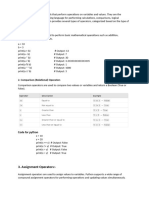Debugging - Jupyter Notebook
Uploaded by
Manali GurudattaDebugging - Jupyter Notebook
Uploaded by
Manali GurudattaDebugging
It is very common to make mistakes while programming in any language. Fortunately, python is able to
recognize lots of types of mistakes and tell us what the problem is. The process of identifying and fixing
errors, or bugs, in your code is called debugging. It is very important to learn to debug your code, no matter
how much experience you have programming you will inevitably make a mistake, you must learn to
efficiently identify and fix your mistakes.
Let's go through a few examples
1. Run some code that doesn't work
2. Look at python's output from our mistakes
3. Identify the problem
4. Fix the problem
In [1]: my_dict = {var1: 2, "var2": 16}
---------------------------------------------------------------------------
NameError Traceback (most recent call last)
Cell In[1], line 1
----> 1 my_dict = {var1: 2, "var2": 16}
NameError: name 'var1' is not defined
In [2]: for i in range(6)
print(i)
Cell In[2], line 1
for i in range(6)
^
SyntaxError: expected ':'
In [3]: array = [1,2,3,4,5]
for j in array:
print(array[j])
2
3
4
5
---------------------------------------------------------------------------
IndexError Traceback (most recent call last)
Cell In[3], line 3
1 array = [1,2,3,4,5]
2 for j in array:
----> 3 print(array[j])
IndexError: list index out of range
In [6]: if 5=4:
print('true')
else:
print('false')
Cell In[6], line 1
if 5=4:
^
SyntaxError: cannot assign to literal here. Maybe you meant '==' instead of '='?
In [5]: class MyClass:
def __init__(self,attr1val,attr2val):
self.attr1 = attr1val
attr2 = attr2val
print('attr2 is equal to',attr2)
myobj = MyClass(5,6)
print('attr1 is equal to', myobj.attr1)
myobj.attr2
attr2 is equal to 6
attr1 is equal to 5
---------------------------------------------------------------------------
AttributeError Traceback (most recent call last)
Cell In[5], line 10
7 myobj = MyClass(5,6)
9 print('attr1 is equal to', myobj.attr1)
---> 10 myobj.attr2
AttributeError: 'MyClass' object has no attribute 'attr2'
In [4]: import numpy as np
nparray = np.array([1,2,3,4,5,6])
mean(nparray)
---------------------------------------------------------------------------
NameError Traceback (most recent call last)
Cell In[4], line 3
1 import numpy as np
2 nparray = np.array([1,2,3,4,5,6])
----> 3 mean(nparray)
NameError: name 'mean' is not defined
In [ ]:
You might also like
- Unit1 7) Types of Errors While Working With Python.ipynb - ColabNo ratings yetUnit1 7) Types of Errors While Working With Python.ipynb - Colab3 pages
- Debugging: Michael Ernst CSE 140 University of WashingtonNo ratings yetDebugging: Michael Ernst CSE 140 University of Washington21 pages
- Exception Handling - Jupyter Notebook_4f2dd58d93b90c15b6532190771836c1No ratings yetException Handling - Jupyter Notebook_4f2dd58d93b90c15b6532190771836c19 pages
- Debugging Methods (From Code Samples Finding and ChatGPT Generate)No ratings yetDebugging Methods (From Code Samples Finding and ChatGPT Generate)26 pages
- Python: Notice That The Shell Shows " (DEBUG ON) ". Note That The Debug Control Window Is OpenedNo ratings yetPython: Notice That The Shell Shows " (DEBUG ON) ". Note That The Debug Control Window Is Opened16 pages
- vertopal.com_Dalia Bortel [ ML Lab 1] (1) (2)No ratings yetvertopal.com_Dalia Bortel [ ML Lab 1] (1) (2)4 pages
- Module 2: Fundamentals of Python Programming LanguageNo ratings yetModule 2: Fundamentals of Python Programming Language42 pages
- Dejene Chala Stat606 Screening Quiz Programming PartNo ratings yetDejene Chala Stat606 Screening Quiz Programming Part12 pages
- MP2 Exercise 02 - NumPy Indexing and SelectionNo ratings yetMP2 Exercise 02 - NumPy Indexing and Selection4 pages
- High Level Impacts GST Training & SAP Landscape - High Level Impacts. Compliance To Legal Requirements? Efficiency That Reduces Costs?No ratings yetHigh Level Impacts GST Training & SAP Landscape - High Level Impacts. Compliance To Legal Requirements? Efficiency That Reduces Costs?9 pages
- Earth and Life Science SHS 3.2 Four Subsystems of EarthNo ratings yetEarth and Life Science SHS 3.2 Four Subsystems of Earth15 pages
- Flyer Rosemount Wireless Permasense Corrosion Erosion Monitoring System For Refineries en 5390998No ratings yetFlyer Rosemount Wireless Permasense Corrosion Erosion Monitoring System For Refineries en 53909982 pages
- (Ebook) Linear Feedback Control: Analysis and Design with MATLAB (Advances in Design and Control) by Dingyu Xue, YangQuan Chen, Derek P. Atherton ISBN 9780898716382, 0898716381 - The full ebook with all chapters is available for download100% (1)(Ebook) Linear Feedback Control: Analysis and Design with MATLAB (Advances in Design and Control) by Dingyu Xue, YangQuan Chen, Derek P. Atherton ISBN 9780898716382, 0898716381 - The full ebook with all chapters is available for download59 pages
- Cleaning Public Areas: by Mumtazul IlyaniNo ratings yetCleaning Public Areas: by Mumtazul Ilyani27 pages
- A fully digital approach to replicate peri-implant soft tissue contours and emergence profile in the esthetic zoneNo ratings yetA fully digital approach to replicate peri-implant soft tissue contours and emergence profile in the esthetic zone5 pages
























































































